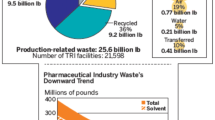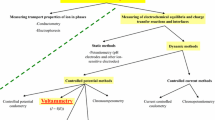Abstract
I argue in the paper that classical chemistry is a science predominantly concerned with material substances, both useful materials and pure chemical substances restricted to scientific laboratory studies. The central epistemological and methodological status of material substances corresponds with the material productivity of classical chemistry and its way of producing experimental traces. I further argue that chemist’s ‘pure substances’ have a history, conceptually and materially, and I follow their conceptual history from the Paracelsian concept of purity to the modern concept of pure stoichiometric compounds. The history of the concept of ‘pure substances’ shows that modern chemists’ concept of purity abstracted from usefulness rather than being opposed to it. Thus modern chemists’ interest in pure chemical substances does not presuppose a concept of pure science.
Similar content being viewed by others
Notes
See also Siegfried (2002).
See, in particular, Needham (1996) and Bensaude-Vincent (1998). Both authors argue that the Aristotelian concept of mixts had a longue durée and that modern chemists were still influenced by it. By contrast, I argue that one of the characteristic features of classical chemist’s understanding of chemical compounds is agnosticism with respect to a number of problems discussed in the Aristotelian and other philosophical schools.
The term “material substances” here denotes both useful materials and pure chemical substances.
I use the term classical chemistry in two senses, to denote a historical period and a part of late modern chemistry. There are additional problems concerning the boundaries of chemistry. Chemistry never was a pure science. The interplay between chemical science and technology is not confined to twentieth-century chemical engineering, materials science and nanotechnology. Nor did it start in the late nineteenth-century, when organic chemistry became a resource of the newly established synthetic dye industry. It rather has a long history. Early modern chemistry had permeable boundaries with pharmacy, mining and metallurgy, manufacture of dyestuffs, ceramics, glass, gunpowder and many other industries.
Exceptions are blowpipe analysis and analysis that relied on mere indicators such as litmus. Both forms of analysis, however, were stabilized, technical procedures that presupposed previous analytical inquiries involving the isolation of components.
It also differed from the spectroscopic analytical methods introduced in twentieth-century chemistry.
The most explicit, early attempt to solve the problem was Claude-Louis Berthollet’s Essai de statique chimique (1803).
In addition to Chalmer’s epistemological answers, I hypothesize that the social and cultural environment of many eighteenth-century and early nineteenth-century chemists—in particular those chemists who were practicing apothecaries, mining officials and state commissioners—did not stimulate philosophical reasoning. It rather encouraged a pragmatic attitude, which helped to focus chemists’ questions on issues that could be tackled in the laboratory.
There were different traditions of alchemy in the early modern period. The following account does not cover all traditions, in particular not Robert Boyle’s corpuscular approach to alchemy. It should be noted, however, that Paracelsian alchemy was a widespread tradition in the late sixteenth and seventeenth centuries.
However, chemists did not abstract from all types of observable properties in contexts of conceptual inquiry, and their identification of distinct kinds of pure chemical substances did not exclusively rely on composition. First, in the case of simple substances that could not be decomposed (later: “chemical elements”) composition was excluded as a criterion for identification. Second, all compounds were identified according to knowledge of chemical composition and additional criteria; to the latter belonged the so-called “chemical properties,” tested with reagents, measurable, physical properties and some other observable properties (such as shape of crystals). Chemists’ identification of substances relied to some extent on connoisseurship, since there was no general rule which observable property of a substance counted for its identification.
He speaks of chemists’ “materialisme instruit par l’énorme plurality des matières differentes” (Bachelard 1963, p. 4.).
Ibid. p. 63; see also see also Bachelard (1973). In the wake of Bachelard, Bensaude-Vincent has recently argued that it was Lavoisier who reduced the infinite variety of individual substances through his introduction of a concept of pure chemical species (Bensaude-Vincent 2011, 110–111). By contrast, I argue that long before Lavoisier, alchemists and chemists undertook efforts to distinguish between kinds or species of substances and their individual varities; and further that the modern concept of chemical species or kind of chemical substance was established in the early eighteenth century and presented in eighteenth-century affinity tables.
The German chemist Georg Ernst Stahl had presented a theory of different orders of chemical composition. See Klein and Lefèvre (2007, 230–231).
By contrast, Bensaude-Vincent (1998) has argued that the Aristotelian concept of natural mixts was a crucial concept in the entire Pre-Lavoisierian eighteenth-century chemistry (see note 3).
All of these examples are presented in the contributions to Klein and Spary (2010).
A recent, valuable book edited by two philosophers of chemistry is entitled Stuff: The Nature of Chemical Substances. There is a general trend, however, in this book to highlight not particular kinds or classes of chemical substances but rather the abstract concepts of stuff and matter (Ruthenberg and van Brakel 2008).
Individuation and identification of a kind (or species) of chemical substance is the most basic form of classification in chemistry as well as in natural history. We have shown elsewhere in detail that it involved coordinated work on many different levels (Klein and Lefèvre 2007).
References
Bachelard, G.: Le matérialisme rationnel, 2nd edn. Presses Universitaires de France, Paris (1963)
Bachelard, G.: Le pluralisme cohérent de la chimie moderne. Vrin, Paris (1973)
Bensaude-Vincent, B.: Éloge du mixte: matériaux nouveaux et philosophie ancienne. Hachette Littératures, Paris (1998)
Bensaude-Vincent, B.: Managing collections of elements: strategies of classification in chemistry. In: Lourenço, M.C., Carneiro, A. (eds.) Spaces and Collections in the History of Science, pp. 149–157. Museum of Science of the University of Lisbon, Lisbon (2009)
Bensaude-Vincent, B.: The concept of materials in historical perspective. NTM 19, 107–123 (2011)
Chalmers, A.: The Scientist’s Atom and the Philosopher’s Stone: How Science Succeeded and Philosophy Failed to Gain Knowledge of Atoms. Springer, Dordrecht (2009)
Chalmers, A.: Boyle and the origins of modern chemistry: Newman tried in the fire. Stud. Hist. Philos. Sci. 41, 1–10 (2010)
Klein, U.: Verbindung und Affinität. Birkhäuser, Basel (1994)
Klein, U.: Experiments, Models, Paper Tools: Cultures of Organic Chemistry in the Nineteenth Century. Stanford University Press, Stanford (2003)
Klein, U.: Technoscience avant la lettre. Perspect. Sci. 13(2), 226–266 (2005)
Klein, U.: Ein Bergrat, zwei Minister und sechs Lehrende. Versuche der Gründung einer Bergakademie in Berlin. NTM 18(4), 437–468 (2010)
Klein, U., Lefèvre, W.: Materials in Eighteenth-Century Science: A Historical Ontology. MIT Press, Cambridge (2007)
Klein, U., Spary, E.C. (eds.): Materials and Expertise in Early Modern Europe: Between Market and Laboratory. University of Chicago Press, Chicago (2010)
Le Febvre, N.: A Compendious Body of Chemistry. Teaching the Whole Practice thereof by the most Exact Preparation of Animals, Vegetables and Minerals, Preserving their essential Virtues. 2 vols. Ratcliffe, London (1664)
Needham, P.: Aristotelian chemistry: a prelude to Duhemian metaphysics. Stud. Hist. Philos. Sci. 27, 251–269 (1996)
Newman, W.R.: Atoms and Alchemy: Chemistry and the Experimental Origins of the Scientific Revolution. University of Chicago Press, Chicago (2006)
Rocke, A.: Chemical Atomism in the Nineteenth Century. From Dalton to Canizzaro. Ohio State University Press, Columbus (1984)
Siegfried, R.: From Elements to Atoms. A History of Chemical Composition. American Philosophical Society, Philadelphia (2002)
Ruthenberg, K., van Brakel, J. (eds.): Stuff: The Nature of Chemical Substances. Königshausen & Neumann, Würzburg (2008)
Usselman, M.C., Rheinhart, C., Foulser, K., Rocke, A.: Restaging Liebig: a study in the replication of experiments. Ann. Sci 62, 1–55 (2005)
Author information
Authors and Affiliations
Corresponding author
Additional information
This paper draws on Klein and Lefèvre (2007). Here, I make some of our arguments more concise and further respond to some criticism. I have greatly benefited from discussion with friends and colleagues. I thank, in particular, Alan Chalmers for clarifying and stimulating discussions.
Rights and permissions
About this article
Cite this article
Klein, U. Objects of inquiry in classical chemistry: material substances. Found Chem 14, 7–23 (2012). https://doi.org/10.1007/s10698-011-9122-0
Published:
Issue Date:
DOI: https://doi.org/10.1007/s10698-011-9122-0




